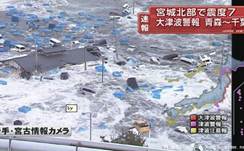
题目列表(包括答案和解析)
Japanese is less interesting than maths.
Japanese is ________ ________ interesting ________ maths.
请认真阅读下面短文,并根据短文内容回答问题。
A 9.0-magnitude earthquake occurred
off the northeastern coast of Japan on 11 March
The earthquake in Japan on March 11,2011 was a 9.0 on the Richter scale (里氏). Over 6,500 died because of the disaster by March 18. The earthquake also caused a tsunami (海啸) and a nuclear leak (核泄漏).
However, most Japanese people stayed calm and orderly.They left broken houses calmly. They waited in line for food, water and public telephones. There was no robbing (抢劫) and no pushing.
Earthquakes hit Japan almost every year. People are ready for an earthquake at any time.
In Japan, you can learn about earthquakes on TV and in schoolbooks. Even the famous comic, Sakura Momoko (《樱桃小丸子》), shows earthquake training in a school. Almost every family in Japan has a survival kit (救生包). The kit has a flashlight (手电筒), a radio, water and enough food for several days.
Most buildings in Japan use wood. The material is less dangerous during a disaster. The buildings can stand an earthquake of up to 7.0 on the Richter scale.
【小题1】How large was the earthquake in Japan on March 11?
【小题2】What did the earthquake cause besides many people’s death?
【小题3】Where can Japanese people learn about earthquakes?
【小题4】What are most buildings in Japan made of?
【小题5】What can we learn from Japanese people if the disaster happens to us?
请认真阅读下面短文,并根据短文内容回答问题。
A 9.0-magnitude earthquake occurred
off the northeastern coast of Japan on 11 March

The earthquake in Japan on March 11,2011 was a 9.0 on the Richter scale (里氏). Over 6,500 died because of the disaster by March 18. The earthquake also caused a tsunami (海啸) and a nuclear leak (核泄漏).
However, most Japanese people stayed calm and orderly.They left broken houses calmly. They waited in line for food, water and public telephones. There was no robbing (抢劫) and no pushing.
Earthquakes hit Japan almost every year. People are ready for an earthquake at any time.

In Japan, you can learn about earthquakes on TV and in schoolbooks. Even the famous comic, Sakura Momoko (《樱桃小丸子》), shows earthquake training in a school. Almost every family in Japan has a survival kit (救生包). The kit has a flashlight (手电筒), a radio, water and enough food for several days.
Most buildings in Japan use wood. The material is less dangerous during a disaster. The buildings can stand an earthquake of up to 7.0 on the Richter scale.
1.How large was the earthquake in Japan on March 11?
2.What did the earthquake cause besides many people’s death?
3.Where can Japanese people learn about earthquakes?
4.What are most buildings in Japan made of?
5.What can we learn from Japanese people if the disaster happens to us?
Tom thinks Japanese is ________ difficult than English.
little
least
less
much
湖北省互联网违法和不良信息举报平台 | 网上有害信息举报专区 | 电信诈骗举报专区 | 涉历史虚无主义有害信息举报专区 | 涉企侵权举报专区
违法和不良信息举报电话:027-86699610 举报邮箱:58377363@163.com